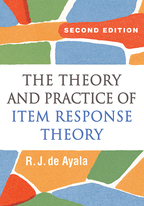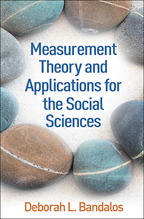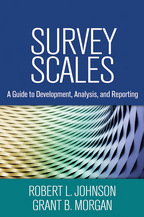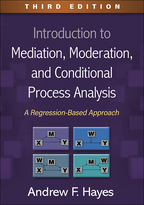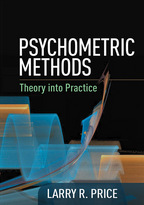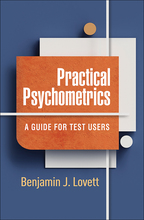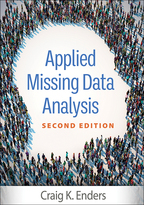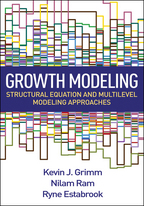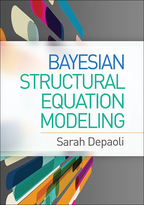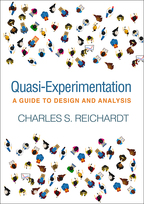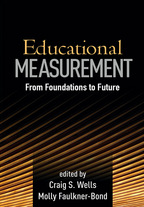The Theory and Practice of Item Response Theory
Second Edition
R. J. de Ayala
1. Introduction to Measurement
- Measurement
- Some Measurement Issues
- Item Response Theory
- Classical Test Theory
- Latent Class Analysis
- Summary
2. The One-Parameter Model
- Conceptual Development of the Rasch Model
- The One-Parameter Model
- The One-Parameter Logistic Model and the Rasch Model
- Assumptions Underlying the Model
- An Empirical Data Set: The Mathematics Data Set
- Conceptually Estimating an Individual’s Location
- Some Pragmatic Characteristics of Maximum Likelihood Estimates
- The Standard Error of Estimate and Information
- An Instrument’s Estimation Capacity
- Summary
3. Joint Maximum Likelihood Parameter Estimation
- Joint Maximum Likelihood Estimation
- Indeterminacy of Parameter Estimates
- How Large a Calibration Sample?
- Example: Application of the Rasch Model to the Mathematics Data, JMLE, BIGSTEPS
- Example: Application of the Rasch Model to the Mathematics Data, JMLE, mixRasch
- Validity Evidence
- Summary
4. Marginal Maximum Likelihood Parameter Estimation
- Marginal Maximum Likelihood Estimation
- Estimating an Individual’s Location: Expected A Posteriori
- Example: Application of the Rasch Model to the Mathematics Data, MMLE, BILOG-MG
- Metric Transformation and the Total Characteristic Function
- Example: Application of the Rasch Model to the Mathematics Data, MMLE, mirt
- Summary
5. The Two-Parameter Model
- Conceptual Development of the Two-Parameter Model
- Information for the Two-Parameter Model
- Conceptual Parameter Estimation for the 2PL Model
- How Large a Calibration Sample?
- Metric Transformation, 2PL Model
- Example: Application of the 2PL Model to the Mathematics Data, MMLE, BILOG-MG
- Fit Assessment: An Alternative Approach for Assessing Invariance
- Example: Application of the 2PL Model to the Mathematics Data, MMLE, mirt
- Information and Relative Efficiency
- Summary
- Conceptual Development of the Three-Parameter Model
- Additional Comments about the Pseudo-Guessing Parameter, Xⱼ
- Conceptual Parameter Estimation for the 3PL Model
- How Large a Calibration Sample?
- Assessing Conditional Independence
- Example: Application of the 3PL Model to the Mathematics Data, MMLE, BILOG-MG
- Fit Assessment: Conditional Independence Assessment
- Fit Assessment: Model Comparison
- Example: Application of the 3PL Model to the Mathematics Data, MMLE, mirt
- Assessing Person Fit: Appropriateness Measurement
- Information for the Three-Parameter Model
- Metric Transformation, 3PL Model
- Handling Missing Responses
- Issues to Consider in Selecting among the 1PL, 2PL, and 3PL Models
- Summary
7. Rasch Models for Ordered Polytomous Data
- Conceptual Development of the Partial Credit Model
- Conceptual Parameter Estimation of the PC Model
- Example: Application of the PC Model to a Reasoning Ability Instrument, MMLE, flexMIRT
- Example: Application of the PC Model to a Reasoning Ability Instrument, MMLE, mirt
- The Rating Scale Model
- Conceptual Parameter Estimation of the RS Model
- Example: Application of the RS Model to an Attitudes Towards Condoms Scale, JMLE, BIGSTEPS
- Example: Application of the PC Model to an Attitudes Towards Condoms Scale, JMLE, mixRasch
- How Large a Calibration Sample?
- Information for the PC and RS Models
- Metric Transformation, PC and RS Models
- Summary
8. Non-Rasch Models for Ordered Polytomous Data
- The Generalized Partial Credit Model
- Example: Application of the GPC Model to a Reasoning Ability Instrument, MMLE, flexMIRT
- Example: Application of the GPC Model to a Reasoning Ability Instrument, MMLE, mirt
- Conceptual Development of the Graded Response Model
- How Large a Calibration Sample?
- Information for Graded Data
- Metric Transformation, GPC and GR Models
- Example: Application of the GR Model to an Attitudes Towards Condoms Scale, MMLE, flexMIRT
- Example: Application of the GR Model to an Attitudes Towards Condoms Scale, MMLE, mirt
- Conceptual Development of the Continuous Response Model
- Summary
9. Models for Nominal Polytomous Data
- Conceptual Development of the Nominal Response Model
- Information for the NR Model
- Metric Transformation, NR Model
- Conceptual Development of the Multiple-Choice Model
- How Large a Calibration Sample?
- Example: Application of the NR Model to a General Science Test, MMLE, mirt
- Summary
10. Models for Multidimensional Data
- Conceptual Development of a Multidimensional IRT Model
- Multidimensional Item Location and Discrimination
- Item Vectors and Vector Graphs
- The Multidimensional Three-Parameter Logistic Model
- Assumptions of the MIRT Model
- Estimation of the M2PL Model
- Information for the M2PL Model
- Indeterminacy in MIRT
- Metric Transformation, M2PL Model
- Example: Calibration of interpersonal engagement instrument, M2PL Model, sirt.noharam
- Obtaining Person Location Estimates
- Example: Calibration of interpersonal engagement instrument, M2PL Model, mirt
- Example: Calibration of interpersonal engagement instrument, M2PL Model, flexMIRT
- Summary
11. Linking and Equating
- Equating Defined
- Equating: Data Collection Phase
- Equating: Transformation Phase
- Example: Application of the Total Characteristic Function Equating Method, EQUATE
- Example: Application of the Total Characteristic Function Equating Method, SNSequate
- Example: Fixed-item and Concurrent Calibration Equating
- Summary
12. Differential Item Functioning
- Differential Item Functioning and Item Bias
- Mantel–Haenszel Chi-Square
- The TSW Likelihood Ratio Test
- Logistic Regression
- Example: DIF Analysis of vocabulary test, SAS CMH
- Example: DIF Analysis of vocabulary test, mantelhaen.test and difR
- Example: DIF Analysis of vocabulary test, SAS proc logistic
- Example: DIF Analysis of vocabulary test, glm and difR
- Summary
13. Multilevel IRT Models
- Multilevel IRT–Two Levels
- Example: Equivalence of the Rasch model and its Multilevel Model Parameterization, proc glimmix
- Example: Rasch model estimation, lme4
- Person-Level Predictors for Items
- Example: Person-Level Predictors for Items–DIF Analysis, proc glimmix
- Example: Person-Level Predictors for Items–DIF Analysis, lme4
- Person-Level Predictors for Respondents
- Example: Person-Level Predictors for Respondents–Nutrition Literacy, proc glimmix
- Example: Person-Level Predictors for Respondents, lme4
- Item-Level Predictors for Items
- Example: Item-Level Predictors for Items - Nutrition Literacy, proc glimmix
- Example: Item-Level Predictors for Items - Nutrition Literacy, lme4
- Multilevel IRT–Three Levels
- Example: Three-Level Model Analysis - Nutrition Literacy, proc glimmix
- Example: Three-level analysis of nutrition literacy data, lme4
Appendix A. Maximum Likelihood Estimation of Person Locations
- Estimating an Individual’s Location: Empirical Maximum Likelihood Estimation
- Estimating an Individual’s Location: Newton’s Method for MLE
- Revisiting Zero Variance Binary Response Patterns
Appendix B. Maximum Likelihood Estimation of Item Locations
Appendix C. The Normal Ogive Models
- Conceptual Development of the Normal Ogive Model
- The Relationship between IRT Statistics and Traditional Item Analysis Indices
- Relationship of the Two-Parameter Normal Ogive and Logistic Models
- Extending the Two-Parameter Normal Ogive Model to a Multidimensional Space
Appendix D. Computerized Adaptive Testing
- A Brief History
- Fixed-Branching Techniques
- Variable-Branching Techniques
- Advantages of Variable-Branching over Fixed-Branching Methods
- IRT-Based Variable-Branching Adaptive Testing Algorithm
Appendix E. Linear Logistic Test Model (LLTM)
- Example of LLTM Calibration using eRm
- Appendix F. Mixture Rasch Model
- Latent Class Analysis
- Mixture Rasch Model
- Example: Application of the mixture Rasch Model to Writing Problem Data, CMLE, WINMIRA
- Example: Application of the mixture Rasch Model to Writing Problem Data, CMLE, psychomix
Appendix G. Miscellanea
- Using Principal Axis for Estimating Item Discrimination
- Infinite Item Discrimination Parameter Estimates
- Example: NOHARM Unidimensional Calibration
- An Approximate Chi-Square Statistic for NOHARM
- Relative Efficiency, Monotonicity, and Information
- FORTRAN Formats
- Odds, Odds Ratios, and Logits
- The Person Response Function
- Linking: A Temperature Analogy Example
- Should DIF Analyses Be Based on Latent Classes?
- The Separation and Reliability Indices
- Dependency in Traditional Item Statistics and Observed Scores
- Conditional Independence using Q₃
- Standalone NOHARM Calibration of interpersonal engagement instrument, M2PL Model
- CFI, GFI, M₂, RMSEA, TLI, and SRMR
- An Introduction to Kernel Equating
- Correspondence between the Rasch model and a Loglinear model
- R Introduction
References
Author Index
Subject Index
About the Author

